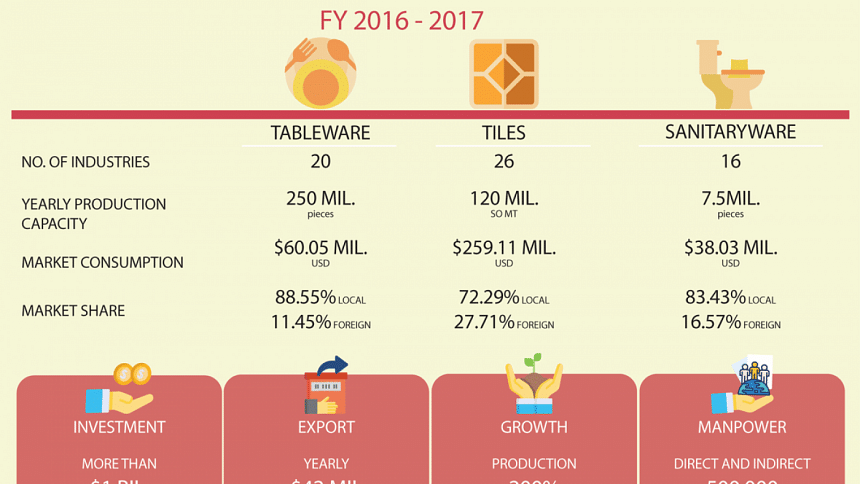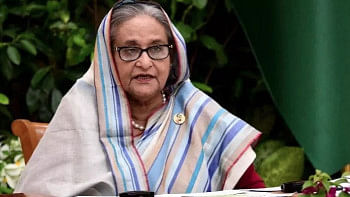Growth momentum building up

Since its inception in 1958, Bangladesh's ceramics industry has proven to be a promising sector for the country's growth and economy. The industry, launched with a small manufacturing plant of Tajma Ceramic Industries in Bogra, is now a body of over 62 ceramic manufacturers, earning profits for many industrialists.
The ceramics industry in Bangladesh serves over 88% of the market with tableware, sanitaryware and tiles. Alongside, the production of glasses, electrical components, refractories, etc. is also supported by this sector. Ceramic products also occupy the export market of the country, making way for a yearly export worth $42 million.
“Bangladeshis have transformed their lifestyle over the years. For instance, tiles have almost completely replaced mosaic in households. Thus, local demand for ceramics products is extremely high, which is being efficiently met by the country's ceramics industry. In the near future, we hope to strengthen our stakes in the global export market,” asserts Md. Shirajul Islam Mollah MP, President of the Bangladesh Ceramics Manufacturers and Exporters Association (BCMEA). He backed his claim by adding that Bangladesh's low labour cost, relative to the quality and production, gives it an edge over traditional manufacturers across the globe. Moreover, a rich source of liquefied natural gas, required for the production of ceramics, will help the industry sustain its ever growing production. If the positive trend continues, then the 200% growth seen over the last five years may change to an even more impressive estimate.
The first international exhibition on the ceramics industry in Bangladesh was held last year to celebrate the emerging global presence of the industry. The Ceramic Expo Bangladesh 2017 highlighted the success stories of the industry while exhibiting ceramic products to local and international ceramic manufacturers, buyers, and investors. The expo was an unexpected success and an even bigger event is scheduled for the upcoming year, which is hoped to be a greater success through a farther reach in the global arena, showcasing both local and foreign models.

As the industry's dominance surges with increasing manufacturing plants and bulk operations, it leaves a positive impact in the employment crisis in Bangladesh. Shirajul Islam said that it's fairly easier for students with honours or diploma in glass and ceramics engineering and related subjects to secure a job in the industry. The theoretical and technical knowledge prepares them for the workplace where they are further trained on the practical implementations. The current balance in the ratio between job availability and eligible employees has made the sector appealing for interested job seekers. At present, over 500,000 people constitute the local workforce.
However, there remain challenges. Even though the country's ceramics industry is excelling in the production of finished products, it has to heavily depend on foreign sources for raw materials. One of the biggest issues is the unloading of these materials at the Chittagong port, as mother vessels are kept waiting at the outer anchorage. This delay, be it even by a day, becomes too costly and generates losses for manufacturers. An alternative to this hurdle can be to lift the bar on the number of cargo vessels.
Port facilities should be improved to expedite the export-import process. This is certainly a challenge that can be overcome. Mr. Shirajul Islam noted that the government has subsidised duty benefits on import. He said, “I am thankful to the government for revising the duty structure and for supporting the establishment of the industry.” Nonetheless, the government can fuel the growth by offering a greater incentive of 15% to exporters and thus, attract more investments in the sector.
Furthermore, reliance on the national capacity for raw material production should be encouraged. For instance, white clay, one of the preliminary raw materials for ceramics, is widely imported from abroad even when there is a rich mine located in Mymensingh that can yield up to 2.57 million tons of clay. Additionally, surface to near surface deposits of white clay are also reported to be produced in Chittagong, Sherpur and Netrokona districts.
The demand for ceramics in Bangladesh is sure to rise in the future. New home buyers, and even renovators, now have the option of choosing tiles and coordinating colours for sanitaryware from the range of products available. Citizens today are more conscious of their choices and with easy access to the global picture, they are more knowledgeable about the product quality, and prefer rich product diversity and a constantly updating catalog. Potteries and tableware for home décor is also a popular subject in the area. Hence, the ceramics industry and prospective investors see excellent opportunities in the local market. Because of their efficient performance in controlling quality and maintaining product diversity, the industry can confidently focus on their influence on the global market. Even with the current efforts, Bangladesh's ceramics export makes considerable contribution to the Bangladesh Bank reserve. This industry can conveniently follow the garments sector, in terms of exports, and be a key participant of the economic development process of the country. Naturally, other key stakeholders, such as the government, should recognise the merits of this industry and support it wholeheartedly. If the ongoing trend continues, Bangladesh can soon become one of the prominent exporters of ceramics in the world.
Noshin Noorjahan is a contributor to The Daily Star

 For all latest news, follow The Daily Star's Google News channel.
For all latest news, follow The Daily Star's Google News channel. 



Comments